
Lisbon, Porto and the Duoro River Valley have become “all the rage”.
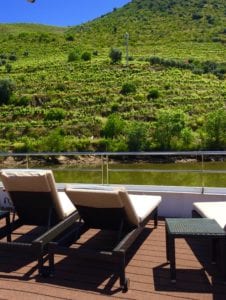
One of the Great European River Journeys
The Duoro Valley east of Porto, in northern Portugal, was designated a UNESCO World Heritage Site, due to it’s scenic beauty and wine producing history dating back 2,000 years.
My husband and I left the hustle and bustle of Lisbon and Porto to board the Viking Torgil for a luxury Viking River Cruise on the Duoro River. We chose a river cruise for our Portugal trip because of the ease of travel, the relaxation onboard and the variety of free tours and excursions.
 Cruising the Duoro River is a journey in a class of its own.
Cruising the Duoro River is a journey in a class of its own.
“I feel like we are journeying back in time,” Gary commented as we passed arched Roman aqueducts. I compared the Duoro vineyards to other famous wine areas in the world, commenting: “We’re not on roads or in a vehicle, like in South Africa or Napa. And best of all, we’re floating by famous vineyards while sipping Porto wine on the sun deck by the pool.”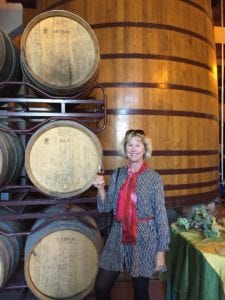
For a wine enthusiast like my husband, it was thrilling to witness the history Portuguese wine unfold on our river cruise upstream. We watched vintners tending their vines in the fields. Pruning, harvesting and stomping of the grapes is still done by hand – and foot. In the harvest season, if you time it just right, you may be able to take part in the ancient practice of crushing and pressing grapes with your feet. Picking grapes, carrying heavy baskets up and down the steep ledges is backbreaking work.
One day we stopped for a tour and a tasting of aged Port wine at Sandemans wine estate, a property that has been in the family for generations.
Speaking of wine, every day on board we sampled delicious Portuguese wines unavailable in the USA. Some are meant to be drunk immediately; others were aged Port wines you would save for a special celebration. Portuguese wines represent the best of European varietals (Cabernet, Chardonnay, Syrah), as well as some 200 native grapes.
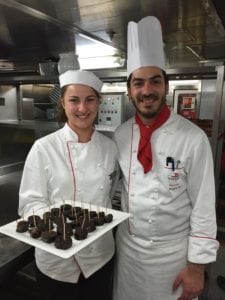
 The culinary treats didn’t stop at the wines and delicacies of the sea, but continued with rich stews, fresh vegetable dishes and fantastic desserts. One afternoon the chef offered a cooking class for those of us who raved about the famous pasteis de Belem. He taught us how to make the simple tarts of flaky pastry filled with custard, topped with cinnamon. After the class, I pigged out and ate a half dozen little two-inch tarts before dinner. That’s a guilt-free vacation to me!
The culinary treats didn’t stop at the wines and delicacies of the sea, but continued with rich stews, fresh vegetable dishes and fantastic desserts. One afternoon the chef offered a cooking class for those of us who raved about the famous pasteis de Belem. He taught us how to make the simple tarts of flaky pastry filled with custard, topped with cinnamon. After the class, I pigged out and ate a half dozen little two-inch tarts before dinner. That’s a guilt-free vacation to me!
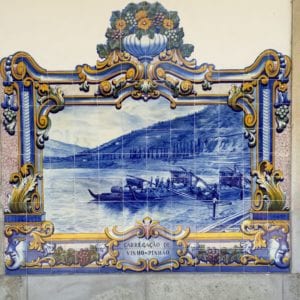
On the fifth day of the cruise we visited the sleepy town of Pinhao, in the epicenter of the winemaking region. During the harvest season the village explodes with workers and wine aficionados from around the world. 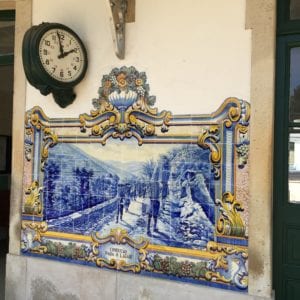
All to quickly Portuguese vacation came to an end. We ventured from the well-worn European circuit of England and France to explore a small, seductive country and we’d seen enough to know we’d be back. 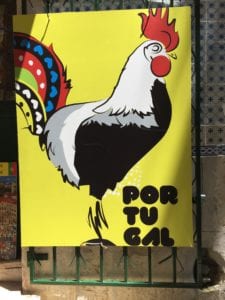
Next trip, my third in as many years, we’ll explore a little deeper into the countryside. Here are the areas I’d like to see and where to find more information.

Guadiana River Valley:
The Guadiana, is a river referred to, by the Romans, as the River of Ducks, or Flumen Anas. The Moors called it Uádi Ana – finally it was named the Ouadiana after the “Reconquista”. For more than 60 miles, the Guadiana forms the border with Spain, ending in the Atlantic, at Vila Real de Santo Antonio. It touches most of the Alentejo region, flowing onto the Algarve.
The Great Lake, taking its name from the town of Alqueva, was formed by a dam, and is, today, the largest human-made lake in Europe, with a reservoir of 155m2. The lake has brought a new environment to this region: where once there were fields of olive trees, cork oaks, today there is water and renewed life, with great conditions for outdoor activities and for water sports such as sailing. On the other hand, while houseboats have been available for rent for several years, the new São Lourenco do Barrocal is the first real 5-star hotel to open with several others being also planned – alongside with a handful of new restaurants.
Many historic towns on the outskirts of the Guadiana have also become a destination in their own right: Mértola, with its ruined castle, medieval streets, and an ancient mosque; Serpa, known for its olive oil and vast aqueduct; and Moura – a charming town well preserved in its walls.
Meet Aljezur, the other Algarve
No high-rises, no big shopping malls… just clean and lovely Atlantic beaches… that’s Aljezur. High cliffs hiding sandy coves and dunes mark the coast. This is a place of rolling hills covered with grass as far as the eye can see; between them, a wide area of fertile fields and valleys cultivated with traditional crops. Aljezur is the perfect place to find peace amid the jumbling sounds of the singing birds and the waves crashing on the rocks. It has become a surfing getaway too, with a lot of surf schools making use of its underdeveloped beaches.
Aljezur is a small coastal village filled with typical houses from the rural architecture of the Algarve, mixing colorful borders painted around windows and whitewashed walls.
At the top of the hill, the old castle ramparts are a reminder of a less peaceful past. A cascade of houses roll down the hillside towards the river, where this village thrives as a seaside escape, set within the Costa Vincentina Natural Park.
Aveiro – city of canals and salt (Centro)
Some call Aveiro the “Venice of Portugal” because of its canals and colorful boats… but that’s not at all a fair comparison. Aveiro is the capital of the Ria, a vast lagoon where the River Vouga meets the Atlantic. Aveiro is crisscrossed by canals, full of brightly colored boats – known as “barcos moliceiros.” Founded in the days of the Roman Emperor Marcus Aurelius, Aveiro is now one of the most unique places on the Portuguese coast.
By the 16th century, the salt industry’s boom and the first cod-fishing business made Aveiro the place to be, as it had a great port and lots of top quality salt.
The Ria today is linked to Aveiro through three canals: the Canal das Pirâmides (marked at its entrance by two stone pyramids), which extends into the Canal Central; the Canal de São Roque, which marks the limits of the city to the north-west and separates it from the saltpans; and the Canal dos Santos Mártires (or the Canal do Paraíso) leading to the southwest.
Aveiro’s 19th and 20th-century growth led to the construction of colorful and unique buildings rising up along the Canal Central – the city’s main “street.” The lines of graceful Art Nouveau buildings give way to the Mercado do Peixe (Fish Market), home to fresh fish, and an excellent eatery perched above the market. Try also the wonderful local pastries, the Ovos Moles de Aveiro.
On the Right Bank, the city museum is housed in the former Convento de Jesus, set amid manors and churches; a few new hotels and inns have opened all over the canals. Off the Ria de Aveiro there are beaches, saltpans, and a natural preserve– making Aveiro a great escape.
Lovingly Caminha
Caminha is a fortified border town guarding at the mouth of the River Minho, looking at Spain, in the Northwest border. The river setting and historic charm make this a great base to explore the Minho Region, home to the Vinho Verde wines. Moreover, the Minho region is also full of charming small towns, beaches, and wineries.
Still, this region is much more than just its past. Vilar de Mouros, a picturesque spot in the beautiful rolling green countryside, roughly 3 miles to the north of Caminha, is the setting for a highly popular festival of modern music – Paredes de Coura – held every August and the first of its kind ever to take place in Portugal.
For more info: https://www.visitportugal.com/en